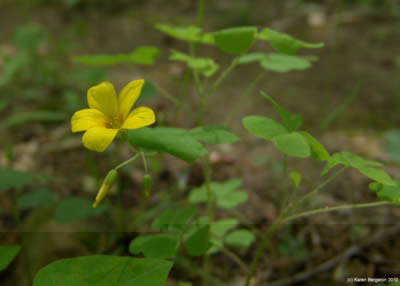Wood Sorrel Herb
Oxalis violacea

Wood Sorrel Herbal and Edible Use
The leaves, flowers, fruits and bulbs of Wood Sorrel are edible and used by herbalists. The entire plant is used as an alternative medicine, it has diuretic, anti-scorbutic and refrigerant actions, and a decoction made from its pleasant acid leaves is given in high fever, both to quench thirst and to allay the fever.
Decoctions of Wood Sorrel herb are used to relieve hemorrhages and urinary disorders, as a blood cleanser, and will strengthen a weak stomach, produce an appetite, and check vomiting. Wood Sorrel juice is used as a gargle and is a remedy for ulcers in the mouth. It is said to be good for healing wounds and to stanch bleeding. Linen cloths soaked with the juice and applied, are held to be effective in the reduction of swellings and inflammation.
Salts of Lemon, as well as Oxalic acid, can be
obtained from Wood Sorrel. 20 lb. of fresh herb
yield about 6 lb. of juice, from which, by
crystallization, between 2 and 3 OZ. of Salts of
Lemon can be obtained and used for many medicinal
purposes. For soaking tired, swollen feet, it is
said to be better than Epsom salts. Excess
internal use of Wood Sorrel should be guarded against, as the
oxalic salts are not suitable to all, especially
those of a gouty and rheumatic tendency, or with
high blood pressure. Several native tribes used
Wood Sorrel to make a kind of refreshing lemonade drink.
Sorrel leaves have a pleasantly acid taste, due to
the presence of considerable quantities of
bin-oxalate of potash. Edible as an attractive and
tasty garnish for spring salads from time
immemorial, they were also the basis of a green
sauce, that was formerly taken largely with fish.
’Greene Sauce,’ says Gerard, ’is good
for them that have sicke and feeble stomaches . .
. and of all Sauces, Sorrel is the best, not only
in virtue, but also in pleasantness of his
taste.’
Other Names: Sheep Sour, Purple Wood Sour, Sour Clover, Sour Trefoil, Purple Stick-wort, Fairy Bells, Hallelujah, Cuckowes Meat, Three-leaved Grass, Trinity Grass, Purple Stubwort, Wild Shamrock, Purple Shamrock, Indian Lemonade, Violet Wood Sorrel
Wood Sorrel Description and Habitat
Wood Sorrel is a perennial native herb found growing in grasslands and openings in woodlands, shaded slopes, gravelly banks and prairies, as well as yards and gardens in Eastern N. America, New York to Wisconsin, south to Florida. Growing from a rose-colored underground bulb are several flowers clustered atop thin stalks up to 8 inches long. The half inch wide flowers, blooming as early as April and May, are usually violet or yellow, but may be white. They are bell-shaped, with five delicate petals. Each leaf is ternate and has three hearth-shaped leaflets, a bright green above, and purplish to dark red on their under surface, especially at the base. The leaflets are usually folded along their middle, and are of a sensitive nature. As the flowers fade, its stalk bends towards the ground and conceals the seed capsule under the leaves, till ripe, when it straightens again. The capsule is elastic and bursts open when the fruit is ripe, throwing the seeds out several yards.
How to Grow Wood Sorrel
Cultivation is fairly easy, through bulb transplants or seed. Plants do best in humus-rich soil in shade or dappled sunlight.
Wood Sorrel Harvesting and Use
Gather entire plant in bloom, use fresh, or dry for later herb use.
Wood Sorrel History and Folklore
The ternate leaf has been considered to be that with which St. Patrick demonstrated the Trinity to the ancient Irish, though it is a tiny kind of clover it is now generally accepted as the ’true Shamrock.’ Violet wood sorrel was first described for science in 1753 by the Swedish father of modern biological taxonomy Carl von Linne (Linnaeus).
Wood Sorrel Recipes
"Medicinal" tea: To 1 heaping tbsp. fresh or 1 tsp. dry herb add 1 cup liquid, may be infused with water or boiled in milk. Take warm at bedtime.
Lemonade: Boil fresh plant or dried herb in water, cool with ice, sweeten to taste. Using dried plant, grind to a fine powder, add sugar, store in air tight container, and you have "lemonade powders without lemons."
Article by Deb Jackson & Karen Bergeron



